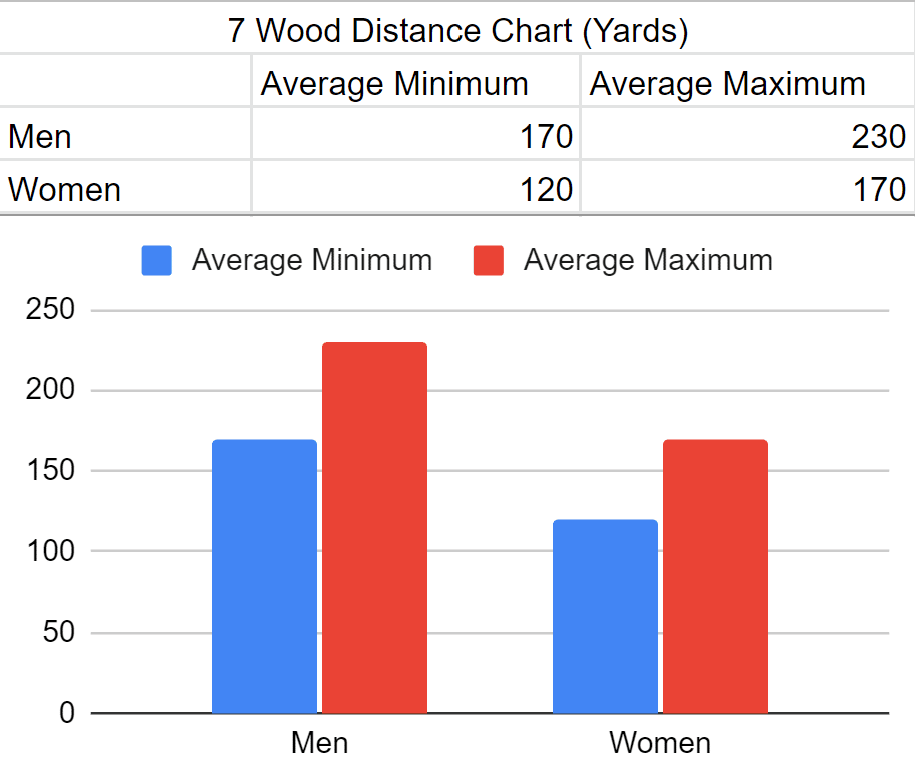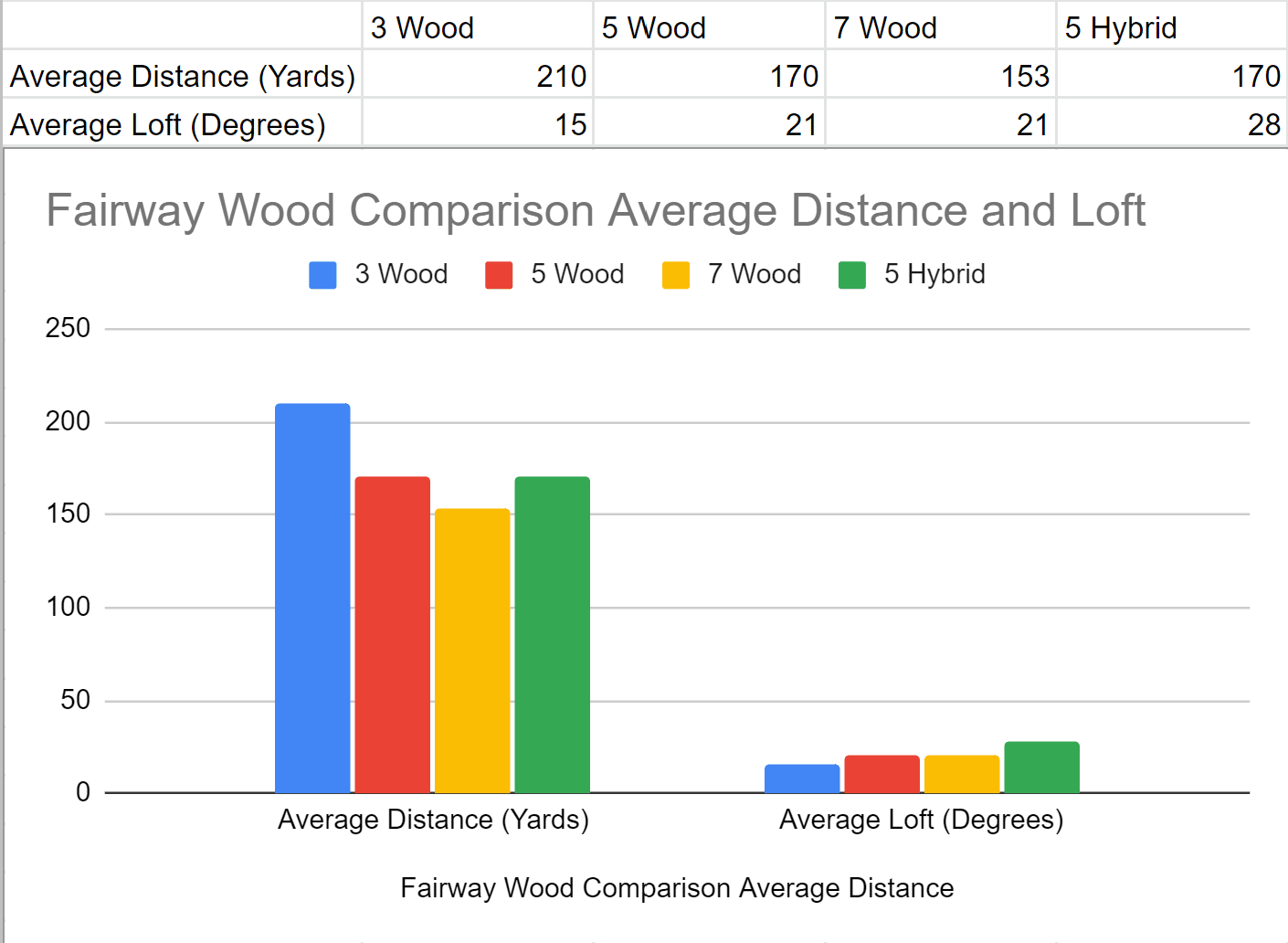The average 7-wood distance for men is between 170 and 200 yards for most golfers. Advanced golfers will average between 200 and 220 yards. PGA Tour players usually hit 7 woods 225 and 250 yards. Most women hit a 7-wood 160 and 190 yards. Advanced women will hit 7 woods between 190 and 210 yards.
The seven wood is a club that often gets overlooked. Stereotypically, they are reserved for female golfers, seniors, or anyone with a slower swing speed. While it’s true that the 7-wood does benefit those with a slower swing speed, it has far more going for it than just that, so much so that the likes of Dustin Johnson, Tommy Fleetwood, and Adam Scott have recently been seen with one of these beasts in their bag.
But the distance you hit a 7 wood also depends on your club and technique. Let’s look at all things 7-wood and why you should consider adding one to your set-up.
What Is a 7-Wood?

I had a hybrid and then the 5-wood. A 5-wood and my 3-wood I hit like the same distance, so [TaylorMade] made me a 7-wood,” he said. “When I first looked at it I’m like, I thought I was going to hit it straight in the air, but I hit it and it came out kind of nice and low with some spin. I was like, all right, put it in the bag.
Dustin Johnson talking about trying his 7-wood for the first time. Source: NBCSports.com
A 7-wood has a larger head than hybrids, 3-woods, and 5-woods. With this size comes more forgiveness, making it an ideal replacement for low irons (2, 3, or 4) and other woods.
In terms of loft, a 7-wood is comparable to a 3-iron, typically featuring 21-22 degrees. Compared with 3-woods or 5-woods, this offers a much higher ball flight.
The length of a 7-wood is typically 40-42 inches, which is about an inch smaller than the average 5-wood. Though they are shorter, they tend to be heavier than the other types of woods — usually by about 10 grams.
What Is The 7-Wood Distance?
The average distance of a 7-wood is between 170 and 200 yards. However, some golfers will be more than capable of reaching 200+ yards with this club. It depends on the club’s quality, the weather/course conditions, and how hard you smack it.
Here are the average 7-wood distances:
- Average 7-wood distance for men:
- High handicappers (25+): 170-180 yards
- Mid handicappers (15-24): 180-200 yards
- Low handicappers (0-14): 200-220 yards
- PGA Tour golfers: 225-250 yards
- Average 7-wood distance for women:
- High handicappers (36+): 160-170 yards
- Mid handicappers (25-35): 170-190 yards
- Low handicappers (0-24): 190-210 yards
- Average 7-wood distance for juniors:
- 12-14 years old: 150-170 yards
- 15-17 years old: 170-190 yards
- 18-21 years old: 190-210 yards
Why Use a Seven Wood?
The enlarged head of the 7-wood, along with the bigger sweet spot, can be greatly beneficial to many golfers. Long irons and 3 or 5-woods can be hard to hit, especially for beginners, but the 7-wood comes full of forgiveness and ease of use.
I’ve found it works great off the tee and the fairway, but I think the larger head is especially useful when I’m hitting out of the rough, as it can batter through thick bits of grass.
Adding to this ease of use is the higher loft. When using low irons, getting the ball up and away can be very difficult, but the 7-wood makes this far easier. This loft also gives you the means to more reliably get over tricky obstacles and a better chance of landing softly on the green.
The shorter shaft length can also work heavily in your favor. Basically, going shorter makes it slightly easier to get a solid impact, giving you more consistency. Sure, this might come at the expense of a bit of distance — but for the average golfer, hitting fairways and greens more regularly will be far more beneficial than squeezing out an extra few yards.
When to Use a 7 Wood?
Perhaps the best thing about the 7-wood is its versatility; it can be used in several scenarios to find greens from a distance and get you out of some tough spots. Here are some of the scenarios where you would be wise to whip out a 7-wood:
- Off the tee, if you’re faced with a tight fairway or long par 3.
- If you’re on the fairway, roughly 200 yards short of the green.
- If you need to clear an obstacle, such as trees or a body of water.
- From the rough, if you’re far from the green.
- If you’re in a fairway bunker with a decent enough lie.
- For approach shots, when you need to land the ball softly on the green more accurately than a 3 or 5 wood.
Heck, I would even chip with my 7-wood around the green. This kind of club lets you get creative with various shots, adding new dimensions to your game.
Read also: Best Club For Chipping
Best 7-Wood Golf Clubs
There are a lot of quality 7-woods out there, most of which could really help to support and bolster your game. Some, however, stand out just a little bit more than others. Here are some of the best picks.
Pros:
- Solid feel
- Perfect for slow swingers
- Flexible through adjustable weights
Cons:
- Intended for newer or intermediate golfers so results will vary for top-tier players
7 Wood Degrees of Loft: 21°
In recent years, Callaway has seemed to be having a lot of fun – and success – by experimenting with cutting-edge technologies for their drivers and woods. For their 2020 range of Mavrik fairway woods, they have taken their ‘Flash Face’ technology and run with it, resulting in a 21-degree 7-wood with exceptional ball speeds and forgiveness.
Callaway has also been dabbling in what they call ‘progressive leading-edge technology.’ In layman’s terms, this basically means that the bottom of the club is angled in such a way as to provide the best possible turf interaction. Coupled with the size and power of the clubhead, this design is a part of a club that could easily help launch your game to new heights.
Pros:
- Attractive design
- Consistent depth
- Forgiving
Cons:
- Not easily adjusted
7 Wood Degrees of Loft: 21°
TaylorMade has continued with its pursuit of perfection in with its Sim2 Max range. Among them is the 7-wood, featuring a loft of 21 degrees. The main piece of technology on offer with this club is TaylorMade’s V steel, which essentially promotes better turf interaction and playability – whether you’re on the fairway or in some nasty rough.
In addition, this club benefits from a carefully designed weight distribution, which basically places the CG in an optimal position for better launch conditions and spin rates. Meanwhile, the clubface has been infused with TaylorMade’s Twist Face technology, which provides excellent ball speeds even on mishits, further increasing this 7-wood’s forgiveness.
Pros:
- Fantastic ball speed
- Adjustable spin
- Multiple shaft options
Cons:
- Pricey
7 Wood Degrees of Loft: 21°
We can’t wait for the upgraded edition of this fantastic club to come out. Until then, the 2021 model is still a firecracker of a club. Callaway build the Epic Max Fairway range from the ground up to provide enhanced ball speed with maximized forgiveness for off-center hits.
Callaway has always had a strong reputation regarding their high loft fairway woods. And, the Epic Max 7 wood delivers on what you’d expect. The oversized head designed by artificial intelligence makes this one of the most forgiving 7 wood clubs on the market. All this adds up to this 7 wood being perfect for those with less experience using a 7 wood. It’s the perfect entry point.
7 Wood Distance FAQ
How Far Does a 7 Wood Go on Average?
For men, you’re likely to hit between 170-230 yards. Women are more likely to achieve a distance between 120-170 yards. Check out the 7 wood distance chart below for an in-depth look.

What Can Replace a 7-Wood or What Club Does a 7-Wood Replace?
Don’t have a 7-wood handy? You could use a 3 hybrid clubs for similar results. A 5-wood or 5 hybrid iron would be the next best option. Check out the comparison chart below for a better understanding.

If we use this chart to compare 7-wood vs 5-hybrid, we can see that, on average, the 5-hybrid will strike farther and higher than the 7-wood. When comparing 5-wood vs 7-wood distance, you’ll see they’re fairly similar and have the same loft angle.
Final Thoughts
A seven-wood isn’t the most commonly used of clubs, but they are clearly growing in popularity. With their increased size, increased loft, smaller shaft length, and heavier weight, they have everything a beginner golfer could need to help them get their shots up and away. But 7-woods aren’t just for beginners; even the pros are taking advantage of the versatility and accuracy of these big-hitting clubs.
Now that you know the 7 wood distances you can better understand whether to add it to your bag. Hey, if it works for the pros, it may work for you as well. Just don’t go trying the 9-wood like Tommy Fleetwood recently did!
Related Articles
- The Best Fairway Woods For High Handicappers
- Which Are The Most Used Golf Grips On Tour?
- The Best Fairway Woods
- How To Hit A Fairway Wood And Become A Consistent Striker
Chris's love for golf is only rivaled by his wanderlust. A globetrotter at heart, He’s played courses throughout Europe and Asia and at home in NSW, Australia. With a writing style as smooth as his golf swing, he’ll help you find the right gear to match your skill level and style. You can connect with Chris on LinkedIn.






